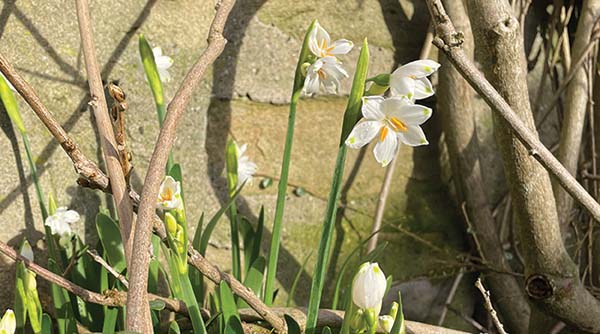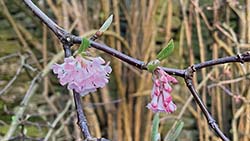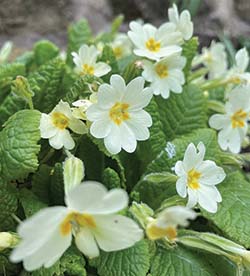

I am a novice at gardening. I enjoy gardening but feel inexperienced and somewhat ignorant. I have some general wishes for my garden but these have not formulated into anything like a plan. I also know that if I don’t stay on top of the garden in spring that it gets away from me: so I have a resolution to spend more time in the garden this spring and summer.
I write this in the early days of February 2024. Signs of new growth are mixed – as is the weather. In terms of the latter it varies from sharp frost, through being mild and wet, to welcome, though short lived, glorious sunshine. I wonder what the plants make of this melange of weather in what is historically a winter month.
I venture out into the garden in the light rain and a welcome patch of sun. I know only a little about gardening, absorbing some knowledge from my expert and enthusiastic mother, and picking up, like a magpie, information from various sources such as plant catalogues, occasional Gardeners’ Question Time listening, and from gazing enviously at well kept gardens in the town and villages. I want to learn more: I feel that much has to be learned by experience and by observation in one’s own garden as well as by talking with others. Why do these snowdrops, in what seems a less likely area, open earlier than those in another which I am sure gets more light and sun?
In this late winter month, it is easy to see the architecture of the garden. Branches, twigs and walls – the underpinning structures of plants and beds – are visible now while later they will be covered as foliage emerges in spring. It is an opportunity to both consider and cut differently to transform or tidy the shape and size of shrubs. It is also a chance to appreciate those tough and glossy evergreens like holly and ivy which steadfastly prevail through winter.
Also clearly visible but lower down are heaps and clumps of dead foliage. Leaves blown off trees have gathered in piles next to walls; twigs are scattered on the mossy grass; brown leaves droop damply from those plants which were so vibrant in autumn – ferns and montbretia. I am uncertain how much to clear the dead leaves: are they important to wildlife – I think so; do they protect new shoots – I think so; do they look a mess – yes! I end up compromising and clearing some but not all of the soggy brown leaves. I glimpse some new green shoots peeping through.
I enjoy catching sight of the first sightings of some of the early spring flowers: a few snowdrops – though not as many as the delightful clusters I see wild on verges around Giggleswick and elsewhere. Today I also see one golden and one pale purple crocus. I recognise the upright shoots of other bulbs: pale green of tulips – one or two green spears unfurling; the brighter green of the plentiful leucojum – pictured above (which I always think of as giant snowdrops); daffodil shoots also. If I look closely I can see tiny buds of leaves on the rose and currant bushes.
Of course alongside the wanted and planned growth is the unplanned presence of weeds – also being encouraged to grow by the light of the longer days (over 90 minutes more light per day now than at the winter solstice). I cut back some of the persistent brambles and dig out some of the tenacious couch grass from the soft soil in one flower bed.

I tie in some leggy winter jasmine – one of those few winter flowering shrubs. I wonder too what an inherited shrub is which has small pink blossom flourishing on this February day. I do an online image search to identify it and discover is is a viburnum ( I have heard of this but did not know what it looked like) – a viburnum farreri. I realise from walks around Clapham and up to Ingleborough Cave that this must be linked to the locally based plant collector who brought many plants back to the UK from Asian travels over a hundred years ago. I spend a happy hour reading about Reginald Farrer (definitely not a novice gardener) and looking out at the garden.
An update from mid March
There has been a gradual tilt in the balance of colours in the garden and surroundings from brown/grey towards green. The bright daffodil leaves are tall; the tiny leaf buds on shrubs are widespread; the willow tree fronds are green. Green is beginning to prevail. The daffodil flowers are emerging slowly and lasting long in this cold and cloudy weather. The pale delicate looking primroses have real stamina in these grey weeks.

I notice that much green in our patch of lawn is from moss rather than grass. I am ever hopeful that one year the lawn will look like the cricket square at Headingley: tiger striped and weed free. There is still some way to go on that gardening journey! I decide that it is just about warm and light enough (we’re getting close to the spring equinox) to spray the lawn, by hand ,with a moss deterrent and a grass accelerant. The moss darkens by the next day and I am able to rake it out to leave space, I hope, for the grass to flourish.
I wondered if there were other novice or experienced or in-between gardeners who might like to write about what they observe and what they do in their gardens. Contributions are welcome!



